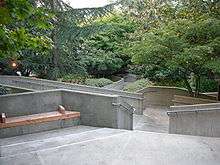Freeway Park
Freeway Park is an urban park in Seattle, Washington, United States, connecting the city's downtown to the Washington State Convention Center and First Hill. The park sits atop a section of Interstate 5 and a large city-owned parking lot; 8th Avenue also bridges over the park. An unusual mixture of brutalist architecture and greenery, the 5.2-acre (21,000 m2) park, designed by Lawrence Halprin's office under the supervision of Angela Danadjieva, opened to the public on July 4, 1976. A later addition to the park opened in 1982 winds several blocks up First Hill, with a staircase and wheelchair ramp.[1]



A series of crimes, notably a January 18, 2002 murder, briefly gave the park a reputation as a haven for crime and led to calls for a radical redesign.[2] Many at first attributed the dangers to the design of the park. A neighborhood group formed under the name Freeway Park Neighborhood Association (FPNA) collaborated with the city's parks and recreation department to produce an "activation plan" for the park, published in 2005 as "A New Vision for Freeway Park". The report concluded that the park's problems could be remedied by numerous small changes: increased security patrols, better lighting, pruning back of certain plants, and above all increased use, both in terms of organized events and simply encouraging more convention center visitors to use the park.[3] The strategy, only partly implemented as of summer 2005, seems to be succeeding: according to David Brewster of the FPNA, crime in the park is down 90% compared to that of 2002.[4][5] The park was renovated in 2008 and renamed to honor civic leader Jim Ellis.[6]
The park is also a cultural landscape and a precedent setting park that defines a new land-use typology for American cities.[7] It was listed on the National Register of Historic Places in 2019.
Gallery
 Brutalist fountain, Freeway Park.
Brutalist fountain, Freeway Park.




References
- Easton, Valerie (July 27, 2008). "In the concrete jungle, Freeway Park will offer respite once again". The Seattle Times. Retrieved October 27, 2019.
- Mudede, Charles (Aug 22–28, 2002). "Topography of Terror". The Stranger. Retrieved 2009-05-31.
- "A New Vision for Freeway Park" (PDF). Seattle Parks Department. Archived from the original (PDF) on 2007-02-18. Retrieved 2005-09-03.
- David Brewster (August 16, 2005). "Freeway Park (interview with David Brewster)". KUOW Weekday. Archived from the original on August 12, 2009. Retrieved 2009-05-31.
- Iwasaki, John (July 19, 2005). "Improvements bringing people back to Freeway Park". Seattle Post-Intelligencer. Retrieved 2009-05-31.
- Gilmore, Susan (September 3, 2008). "Group pushing to rename Freeway Park". The Seattle Times. p. B4. Retrieved October 27, 2019.
- Brice Maryman + Liz Birkholz (2007). "Freeway Park/Past, Present and Future?". The Cultural Landscape Foundation. Archived from the original on 2009-02-28. Retrieved 2009-05-31.
Further reading
- Tate, Alan (2001). Great City Parks. London: Spon Press. ISBN 0-419-24420-4.
External links
| Wikimedia Commons has media related to Freeway Park, Seattle. |
- Freeway Park Association website
- Seattle Parks Official site, accessed 3 Sept 2005
- Three 1988 images of the park.
- Virtual Reality Tour of Freeway Park, requires QuickTime.